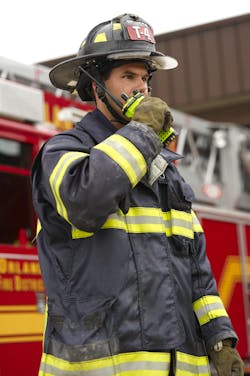Mission-critical data applications require a mission-critical data network. Today, public safety agencies are reliant upon wireless carriers for broadband data, but this is poised to change. The 9/11 Commission highlighted the critical need for interoperable communications among first responders. The Public Safety Alliance was formed to amplify this need and educate Congress on the need for dedicated spectrum and funding to accomplish this goal. In 2012, Congress created FirstNet and charged it with building a nationwide interoperable data network solely for public safety. FirstNet was granted exclusive use of the spectrum and given the task to govern a $7 billion program to plan, build, deploy and operate the network.
Just as consumer use of and reliance upon convenient smartphone and tablet apps is becoming extremely common, public safety use of intelligent data apps will gain traction. While you can download public safety-focused apps on your smartphone, mission-critical apps require a dedicated and secure network—something that will be available with the advent of the public safety broadband network. The following are some key points to consider on this topic.
Network needed
Mission-critical data applications require a mission-critical data network. Today, public safety agencies are reliant upon wireless carriers for broadband data, but this is poised to change. Out of the 9/11 Commission came the Public Safety Alliance charged with building a nationwide interoperable data network solely for public safety. The Alliance granted exclusive spectrum and created FirstNet to govern a $7 billion grant to plan, build, deploy and operate the network.
When coupled with effective voice communications capability, a nationwide public safety LTE network—with speeds similar to what we’ve all come to expect from carriers, but much more reliable, secure and 100 percent dedicated to public safety users—will increase safety, efficiency and collaboration among first responders. A dedicated network also means higher availability for users of the system; it won’t experience latency or downtime during high volume usage. While the timeline for a nationwide rollout is undetermined, pilot programs (such as LA-RICS in Los Angeles to be completed later this year and BigNet in Harris County, TX) are moving forward and will be test cases for fire service, law enforcement and EMS use. As the national network rolls out, application development will only accelerate, as will adoption by public safety agencies.
Converged devices
Mission-critical data intelligence will need to be accessible on converged devices. I don’t foresee a time when two-way radios will go away. Further, firefighters carrying a radio, a smartphone, a tablet and a laptop simply isn’t practical. Before mission-critical voice-over LTE becomes commonplace, vendors will need to develop LTE-enabled radios that incorporate smartphone or tablet functionality, while still delivering mission-critical voice-over LMR. Maintaining voice capability in this new communications environment is essential to the future effectiveness of fire service emergency scene communications.
Employing apps
What applications will the public safety broadband network enable for fire service? Fire-specific data applications can improve situational awareness so incident commanders (ICs) can make faster and better informed decisions on the fireground. We know that every second that passes in an emergency situation can translate into life-saving moments. Fire service vendors are already working together on integrated solutions, which a public safety LTE network will only make more secure and reliable. The following are some data-driven use cases that could transform decision-making during fireground operations.
- Instantaneously monitor firefighter vitals and fireground environmental information: Historically, getting vital and environmental information has been a manual process with incident commanders requesting information from firefighters during personnel accountability reports (PARs). Integrating sensor technology within PPE could provide vital data, such as air tank levels and gas and environmental anomalies automatically. Call out alerts and mayday/man-down assistance requests would be streamlined. Access to this real-time data from sensors would allow ICs to make proactive—or at least more timely—decisions.
- Locate and track fire personnel and assets in real-time: Accountability solutions monitor vitals and environmental factors, but can also be used to track personnel location in both indoor and wildfire scenarios. In indoor situations, sensors deployed at the fireground and on firefighters might be used to create a real-time 3D view of personnel operating in, and around, buildings. In outdoor or wildland scenarios, personnel could also be actively tracked via GPS; however, it’s likely that data coverage will become spotty the farther the incident is away from urban centers. It is envisioned that incident command could deploy drones carrying an LTE repeater to extend data coverage beyond the wildland-urban interface to where it’s needed most. The drone could fly indefinitely, in a stationary position, with a microfilament powering the unit.
- Receive actionable intelligence to enhance situational awareness: Mission-critical LTE will be the backbone for real-time access to multiple databases to improve mid-incident intelligence. Firefighters responding to an incident could access CAD and records information on the move. They could quickly reference fire RMS and GIS data, including street, traffic and weather information, or even building details (schematics, geographical hazards, evacuation plans and property owner information) for enhanced emergency response.
- Improve post-incident investigations: The ability to capture multimedia data could provide additional perspective and a more complete story than written reports alone. Investigators can take crime scene video and audio, and complete automated reports on their smartphone or tablets. This data and information could then be sent immediately for processing over the dedicated network.
Watch and see
These data applications are a small sample of what is planned with the advent of the nationwide public safety broadband network. And we should soon see some of these applications in the real world. It will be exciting to see how local fire departments might take advantage of the LTE network provided by LA-RICS in Los Angeles. Together with the deployment of a new LMR system to enable mission-critical voice, Los Angeles County departments will be prepared on the fireground with two-way radios, and also will be the first in the nation testing fire service mission-critical data. We should all watch how this transpires and the impact it has on the effectiveness of our Southern California colleagues.
About the Author

Dennis Compton
Chief
DENNIS COMPTON is a well-known speaker and the author of several books, including his most recent offering titled Progressive Leadership Principles, Concepts and Tools. He also authored the three-part series of books titled When in Doubt, Lead, the book Mental Aspects of Performance for Firefighters and Fire Officers, as well as many articles, chapters and other publications. Compton was the fire chief in Mesa, AZ, for five years and an assistant fire chief in Phoenix, where he served for 27 years. He is past chairman of the Executive Board of the International Fire Service Training Association (IFSTA) and past chairman of the Congressional Fire Services Institute (CFSI) National Advisory Committee. Compton is currently the chairman of the National Fallen Firefighters Foundation (NFFF) Board of Directors and co-chairs the Fire Service-Based EMS Advocates Steering Committee.
